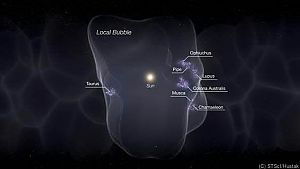Star explosions caused local bubble to form around sun

It has been known for decades that the sun lies in a dust-free cavity about 1,000 light years across. By chance, the Sun lies at its centre.
Using new data from the European Space Agency's Gaia space telescope, which measures the distances and proper motions of billions of stars, scientists led by Catherine Zucker of the Harvard-Smithsonian Center for Astrophysics (USA) have reconstructed the recent history and structure of the Milky Way with much greater accuracy than before. The result is a complete 3D visualisation of the Local Bubble. This is filled with a hot, low-density gas surrounded by a shell of cold, neutral gas. All new, young stars in our galactic environment were and are formed at these edges.
Local bubble caused by 15 supernovae
The history of the local bubble began about 14 million years ago when about 15 so-called supernovae took place over a period of several million years. In these cosmic events, very massive stars explode at the end of their lifetimes. "The most recent of these stellar explosions took place about two million years ago," João Alves of the Institute of Astrophysics at the University of Vienna told APA. Evidence of this explosion in the form of the precipitated isotope iron-60 was discovered by Austrian physicists in 2020 in sediment samples from the deep sea.
The powerful stellar explosions pushed the surrounding interstellar gas outwards and created the Local Bubble. At its edges, the gas condensed and molecular clouds formed, in which stars could eventually form. Seven known, and well-studied, star-forming regions are located on the outside of the bubble.
Sun at the centre "coincidence"
The fact that the Sun is currently located almost exactly in the centre of the local bubble is a "coincidence", Alves emphasised. During the first supernovae that led to the formation of the cavity, the Sun was still far away from it, he said. "But about five million years ago, the galactic orbit of our Sun led our solar system directly into the Local Bubble. And now we're sitting almost right in the centre of it."
Because the cavity will not expand indefinitely - the expansion has already lost its momentum and settled down to a relatively constant speed of six to seven kilometres per second - Alves estimates that our solar system will leave the bubble in another five million years or so. "That will also depend on how many of the massive stars near the Sun explode in that time - there will certainly be some, such as Antares in the heart of the constellation Scorpio," the astrophysicist said.
Earth survived several such bubbles
The Earth must have passed through many such bubbles since its formation around 4.5 billion years ago and survived in the process, Alves emphasises. The question is always what impact this has had on the planet. "Depending on how close we were to a real supernova in the past, the result can range from a nice bright new star in the sky to a mass extinction."
Statistically, it would be very unlikely for the Sun to sit at the centre of such a large bubble if such formations were rare in the Milky Way, the scientists point out. They therefore assume that such bubbles play an important role in galaxies like the Milky Way and that they are riddled with holes like Emmental cheese. Generated by stars dying in supernovae, new stars can always form at the edges of the bubbles. In a next step, the scientists want to measure all interstellar bubbles within reach and thus obtain a complete 3D visualisation of the structure.
